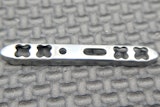Intel Corp. announced Sunday that they have developed a programmable processor that delivers supercomputer-like performance from a single, 80-core chip that is not much bigger than a human fingernail while using less electricity than the average home appliance.
The research chip operates at 3.16 gigahertz and consumes only 62 watts of power – less than most currently available single-core processors.
Intel's chip is a result of its "Tera-scale computing" research aimed at delivering Teraflop, or trillions of calculations per second, crucial to the development of future multi-core and parallel computing performance.
The Teraflop chips mesh-like "network-on-a-chip" architecture allows super high bandwidth communications between the cores, and is capable of moving Terabits of data per second inside the chip.
According to Intel, the ability to move terabytes of data, will play a major role in future computers with ubiquitous access to the Internet by powering new applications for education and collaboration, as well as enabling the rise of high-definition entertainment on PCs, servers and handheld devices.
"Star-Trek-like" innovations such as artificial intelligence, instant video communications, photo-realistic games, multimedia data mining and real-time speech recognition could become a reality with terachip advancements.
Intel will not be marketing the research chip, but the Teraflop research chip does provide insight into new silicon design methodologies, high-bandwidth interconnects and energy management approaches.
In 1996, Intel achieved Teraflop performance for the first time with the ASCI Red Supercomputer built for the Sandia National Laboratory. That computer had a footprint of more than 2000 square feet, was powered by almost 10,000 Pentium processors, and used over 500 kilowatts of electricity.























